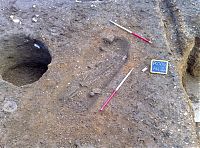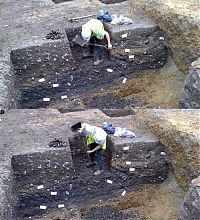On Shovelling and the Roman Cemetery
- By: Ashley Pooley |
- May 07, 2008
- Share
- del.icio.us

Over the past week or so, we have been dealing with Medieval and Post-Medieval gravel quarry pits, and beginning to get to grips with some of the Roman features on site. The weather this week has taken a turn for the better, with brilliant sunshine the norm instead of dreary rain which messes up the site, makes everyone miserable and doing paperwork on-site positively purgatorial.
The pits are quite sizeable and fun to dig out if you like that sort of thing. I do, as it happens, since it necessitates lots of shovelling over fair distances, which is a dying art in these days when site-workers are spoiled by the use of modern machinery. And it gets you fit.

Burial 741, a complete adult inhumation with gravegoods. It is aligned N-S on the main cemetery alignment.
The Roman features which we have been dealing with are connected with the funerary activities within the enormous eastern cemetery, of which the site is a tiny part. Much truncation has occurred in the area which we are currently excavating (Zone 1), chiefly caused by later quarrying and the construction of houses in the 18th and 19th centuries. In addition the soil conditions, largely due to acidity, ensure a poor degree of preservation of any skeletal material still surviving, with largely only limb bones being present. However, we have noticed that the graves so far identified are mainly laid out on a northeast to southwest alignment with only one being arranged northwest to southeast. This may reflect the alignment of a Roman Road identified to the north of our site underneath what is now the Primary School of the Church of the English Martyrs. In addition we have discovered a small remnant of what appears to be a ditch (also aligned northeast to southwest and also of Roman date) which might perhaps reflect an internal subdivision of the cemetery. Exactly what these internal boundaries reflect and express is at present enigmatic. Of the graves themselves, we have noticed that, judging from their size and assuming the skeletons were interred in a supine fashion (which we think we can, based on the presence – however poorly preserved – of limb bones) all apart from one appear to be of juveniles. It is noticeable that, thus far, these also contain no grave goods.
Food for thought…
